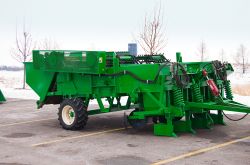While researchers continue work on miscanthus’s viability to produce cellulosic ethanol, and growers now have a way to plant and harvest the feedstock more efficiently. After years of collaboration and research, a miscanthus rhizome regeneration harvester and planter system has been developed. The unveiling took place during the Bioenergy Feedstocks Symposium held at the University of Illinois (U of I). Typically, miscanthus is a labor-intensive crop requiring multiple machines, and costly manual selection and grading – but not any longer.
 The new machine is the result of a three-year collaboration between U of I, Tomax Ltd and Bermuda King USA. According to a news release from U of I, this machinery can lower the cost of miscanthus rhizome production by up to 40 percent and create opportunities for miscanthus to be used more widely as a high-yield bioenergy crop.
The new machine is the result of a three-year collaboration between U of I, Tomax Ltd and Bermuda King USA. According to a news release from U of I, this machinery can lower the cost of miscanthus rhizome production by up to 40 percent and create opportunities for miscanthus to be used more widely as a high-yield bioenergy crop.
Gavin Maxwell, Tomax Ltd Senior Bioenergy Consultant, said, “Bioenergy feedstock processors require security for supply and unless we dealt with regeneration and planting issues for miscanthus, we simply couldn’t make progress. The collaboration team had a very clear objective when beginning the design process of the harvester and planter. Our goal was to remove manual labor, integrate the digging and grading process, increase soil separation and improve both quality and volume to substantially reduce the cost of vegetative rootstock propagation.”
In recent U.S. trials, the machine has demonstrated a 200 percent increase in rhizome collection over manual systems. this allows, says the research team, the opportunity for regional nurseries to more efficiently expand to meet the demand for both solid and liquid fuel conversion. The harvester and planter package will be available beginning this year and will be available for expanded grower crops in time for the 2011 season.

